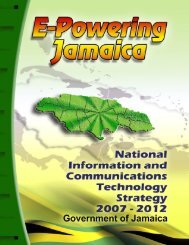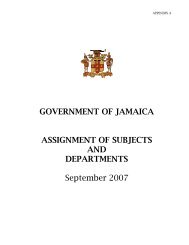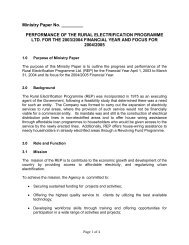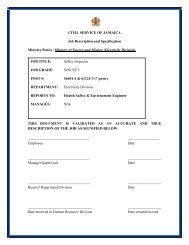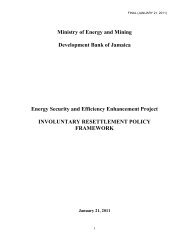Jamaica Biofuels Report - Ministry of Energy
Jamaica Biofuels Report - Ministry of Energy
Jamaica Biofuels Report - Ministry of Energy
Create successful ePaper yourself
Turn your PDF publications into a flip-book with our unique Google optimized e-Paper software.
4. StakeholdersThe following section describes the stakeholders that the education and outreach campaign mustaddress. While all the stakeholder groups listed here must be addressed, there should be a stratification<strong>of</strong> groups to ensure that priority stakeholders (e.g., the general public, government, and media) areaddressed first. How these groups are stratified must be determined by the campaign leadership.1. General publicThe general public primarily refers to the collective group <strong>of</strong> fuel consumers, such aspersonal vehicle owners, large fleet operators industry, manufacturers, etc. The mainopposition to bi<strong>of</strong>uels from this group stems from concerns about vehicle performance whenbi<strong>of</strong>uels are used. A lot <strong>of</strong> these concerns were expressed at the initial E10 rollout, but theysoon died down. There has also been some opposition to growing sugarcane for ethanolbecause <strong>of</strong> a preference for its use in rum. Acceptance by this group is critical to the success<strong>of</strong> bi<strong>of</strong>uels in <strong>Jamaica</strong> as public resistance to bi<strong>of</strong>uels could prevent successful deploymentand misunderstandings about bi<strong>of</strong>uel use and handling would be dangerous. Multiplestrategies that target different populations and are implemented over different timeframesmust be utilized in order to have a sustained and far reaching impact.Issues to address:(a) What bi<strong>of</strong>uels are and how they differ from alcohol, gasoline and diesel;(b) Why bi<strong>of</strong>uels/what the benefits <strong>of</strong> blending bi<strong>of</strong>uels are, including the linkbetween bi<strong>of</strong>uel development and improved roads and infrastructure, direct andindirect jobs, investment and economic development, environmental impacts;(c) What changes they will see (e.g. costs, vehicle performance), problems that mayarise/have arisen and how to address those problems;(d) Demonstrate an understanding <strong>of</strong> issues that have arisen with the E10 roll outand what has been/will be done to improve the situation. Also, how futurepotential issues are being preempted;(e) Bi<strong>of</strong>uel developments in <strong>Jamaica</strong> and the course <strong>of</strong> action that is adopted;(f) How <strong>Jamaica</strong> can maintain and grow its existing granular sugar and rumproduction for domestic and export markets where pr<strong>of</strong>itable returns arepossible while also producing bioethanol and biodiesel;(g) Information to control the spread <strong>of</strong> misinformation (prepare for and managefalse information);(h) Where to go for more information.2. Sugar mill and estate ownersThis is a relatively small group comprising sugar mill and estate owners who are eitheralready in the private sector or all will be once the GoJ divestiture <strong>of</strong> its sugar cane mills and56



